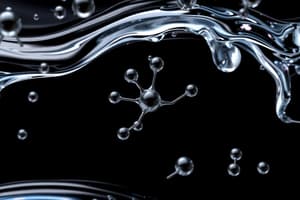Podcast
Questions and Answers
This standard applies to both transparent and opaque liquids.
This standard applies to both transparent and opaque liquids.
True (A)
What is the designation of the standard test method for kinematic viscosity?
What is the designation of the standard test method for kinematic viscosity?
D445
What is the range of kinematic viscosities covered by this test method?
What is the range of kinematic viscosities covered by this test method?
0.2 mm2/s to 300000 mm2/s
The dynamic viscosity, η, can be obtained by multiplying the kinematic viscosity, ν, by the ______.
The dynamic viscosity, η, can be obtained by multiplying the kinematic viscosity, ν, by the ______.
Mercury is safe to handle and does not pose health hazards.
Mercury is safe to handle and does not pose health hazards.
What should users determine regarding mercury-containing products?
What should users determine regarding mercury-containing products?
What is the designation of the standard test method for kinematic viscosity?
What is the designation of the standard test method for kinematic viscosity?
What properties does this test method measure?
What properties does this test method measure?
What is the range of kinematic viscosities covered by this test method?
What is the range of kinematic viscosities covered by this test method?
The dynamic viscosity can be obtained directly without measurement.
The dynamic viscosity can be obtained directly without measurement.
This test method requires a calibrated glass capillary ______.
This test method requires a calibrated glass capillary ______.
What should users consult regarding safety concerns when handling mercury?
What should users consult regarding safety concerns when handling mercury?
The standard addresses all safety concerns associated with its use.
The standard addresses all safety concerns associated with its use.
What type of flow behavior is primarily applicable for the kinematic viscosity measurement in this standard?
What type of flow behavior is primarily applicable for the kinematic viscosity measurement in this standard?
Flashcards are hidden until you start studying
Study Notes
Scope of Standard Test Method D445
- This standard specifies a procedure for determining the kinematic viscosity of liquid petroleum products, both transparent and opaque.
- The kinematic viscosity is measured by the time it takes for a specific volume of liquid to flow through a calibrated glass capillary viscometer under gravity.
- This test method is applicable to liquids that exhibit Newtonian flow behavior, where shear stress and shear rates are proportional.
- The procedure and precision values for residual fuel oils, exhibiting non-Newtonian behaviour under certain conditions, have been included.
- The range of kinematic viscosities covered by this test method is from 0.2 mm2/s to 300 000 mm2/s.
- The dynamic viscosity can be calculated by multiplying the kinematic viscosity by the density of the liquid.
- For measuring kinematic viscosity and viscosity of bitumens, refer to Test Methods D2170 and D2171
Safety Information
- Mercury and mercury-containing products are hazardous to health and corrosive to materials.
- Handle mercury and mercury-containing products with caution.
- Consult the applicable product Safety Data Sheet (SDS) for further safety information.
- The sale of mercury or mercury-containing products may be prohibited by local or national laws.
- Users are responsible for determining the legality of sales in their respective locations.
Development Principles
- This international standard was developed in accordance with internationally recognized principles on standardization.
- These principles were established by the World Trade Organization Technical Barriers to Trade (TBT) Committee in their Decision on Principles for the Development of International Standards, Guides and Recommendations.
Referenced Documents
- This standard references ASTM Standards, including D3... (the text does not specify which ASTM standards are referenced).
Scope Of The Standard
- This standard (D445) outlines a method for determining the kinematic viscosity (ν) of liquid petroleum products.
- It applies to both transparent and opaque liquids.
- The method involves measuring the time for a specific volume of liquid to flow through a calibrated glass capillary viscometer.
- This standard covers a range of kinematic viscosities from 0.2 mm2/s to 300 000 mm2/s.
- The dynamic viscosity (η) can be calculated by multiplying the kinematic viscosity (ν) by the liquid's density (ρ).
- Additional information relates to the measurement of viscosity in bitumens, the connection to ISO 3104, and the distinction between Newtonian and non-Newtonian fluid behavior.
- The standard addresses safety concerns related to mercury and mercury-containing products, highlighting potential health hazards and legal restrictions.
Standard Development Process
- The international standard was developed following internationally recognized principles on standardization.
- These principles were established in the Decision on Principles for the Development of International Standards, Guides, and Recommendations issued by the World Trade Organization Technical Barriers to Trade (TBT) Committee.
Reference Documents
- The standard references other ASTM standards (D3...).
Studying That Suits You
Use AI to generate personalized quizzes and flashcards to suit your learning preferences.




